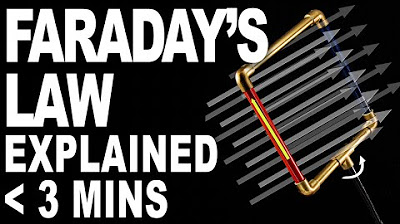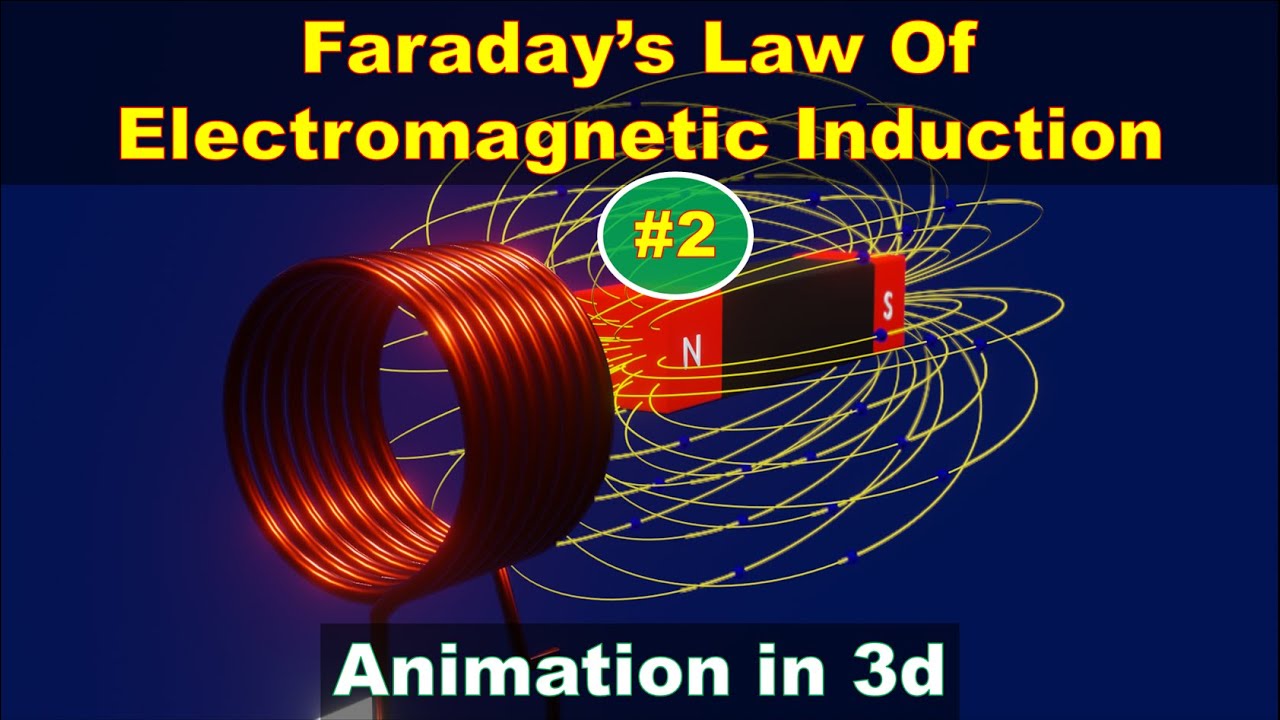Problem from Asia's Toughest Physics Exam
TLDRThe video delves into a challenging physics problem from the Asian Physics Olympiad, exploring the behavior of a magnet falling through a copper tube. The speaker explains the mathematical and physical principles involved, including terminal velocity, differential equations, and Faraday's law. The problem requires deriving the magnet's position over time and calculating the induced electromotive force (EMF) in a ring surrounding the tube. The speaker methodically solves the equations and provides insights into advanced concepts, making it a compelling watch for those interested in complex physics challenges.
Takeaways
- 🔍 The problem involves analyzing the motion of a magnet falling through a copper tube, with the primary force considered being electromagnetic in nature.
- 📉 The magnet does not fall at the standard acceleration due to gravity (9.81 m/s²) but rather falls much slower due to electromagnetic forces.
- 📚 The first step is to find the terminal velocity (Vr) of the magnet by setting acceleration to zero, yielding the equation Vr = mg/k.
- 🔢 The problem requires solving a differential equation to find the position Z(t) of the magnet over time, with initial conditions set to zero.
- ✏️ The solution involves using an integrating factor to simplify the differential equation, ultimately deriving an expression for Z(t).
- 🔄 The expression for Z(t) is found using the product rule and integration by parts, incorporating constants determined by boundary conditions.
- 🌐 The problem transitions to cylindrical coordinates, focusing on the magnet's dipole moment and magnetic field components in the Z direction.
- 🧲 The induced electromotive force (EMF) in a ring surrounding the tube is calculated using Faraday's law, specifically through the loop integral of the cross product of velocity and magnetic field.
- 📏 The magnitude of the induced EMF is proportional to the velocity and the magnetic field component in the radial direction, as well as the loop's circumference.
- 📐 The force opposing the magnet's fall is calculated as proportional to the radial component of the magnetic field, which acts to slow down the magnet.
Q & A
What is the terminal velocity of the magnet as it falls through the copper tube?
-The terminal velocity \( v_R \) of the magnet can be found by setting the acceleration to zero in the governing equation. This gives \( v_R = \frac{mg}{k} \), where \( m \) is the mass of the magnet, \( g \) is the acceleration due to gravity, and \( k \) is a coefficient proportional to the speed of the magnet.
How is the governing equation of the magnet's motion derived?
-The governing equation is derived by considering the forces acting on the magnet. The equation is \( m\ddot{z} = mg - k\dot{z} \), where \( m\ddot{z} \) is the mass times the acceleration, \( mg \) is the gravitational force, and \( k\dot{z} \) is the force proportional to the velocity, representing resistance due to Lenz's law.
What method is used to solve the differential equation for the position \( z(t) \) of the magnet?
-The differential equation is solved using an integrating factor. This involves multiplying both sides of the equation by a function \( f(t) \) that simplifies the left-hand side into a derivative of a product, allowing for easier integration.
What is the integrating factor used to solve the differential equation?
-The integrating factor \( f(t) \) is found to be \( e^{\frac{k}{m}t} \), which simplifies the differential equation by turning the left-hand side into a derivative of the product \( f(t)z(t) \).
What are the boundary conditions used to solve for the constants in the solution?
-The boundary conditions are \( z(0) = 0 \) (the initial position is zero) and \( \dot{z}(0) = 0 \) (the initial velocity is zero). These conditions are used to solve for the constants \( C_1 \) and \( C_2 \) in the general solution.
What is the final expression for the position \( z(t) \) of the magnet over time?
-The final expression for the position \( z(t) \) is \( z(t) = \frac{gm}{k} \left( t - \frac{m}{k} \right) \left( 1 - e^{-\frac{k}{m}t} \right) \), which describes the magnet's position as a function of time, considering both gravitational force and resistive force.
How is the induced electromotive force (EMF) in the ring calculated?
-The induced EMF is calculated using Faraday's Law, which states that the EMF is the negative rate of change of magnetic flux through the ring. An alternative form, suitable when the magnet and ring are moving, uses the loop integral of the cross product of the velocity and magnetic field vectors.
What components of the magnetic field are considered for calculating the induced EMF?
-The radial and axial components of the magnetic field are considered. The cross product of the velocity (in the Z direction) with the radial magnetic field component gives the induced EMF.
What role does Newton's Third Law play in the problem?
-Newton's Third Law indicates that the force exerted by the induced current in the ring on the magnet has the same magnitude but opposite direction as the force exerted by the magnet on the ring. This force opposes the motion of the magnet, slowing it down.
Why is cylindrical coordinate system used in this problem?
-Cylindrical coordinates are used because the magnet is falling through a cylindrical tube, making this coordinate system natural and convenient for analyzing the problem, especially when considering the radial and axial components of the magnetic field.
Outlines
🧲 Introduction to the Magnet Problem in the Asian Physics Olympiad
In this segment, the speaker introduces a challenging problem from the Asian Physics Olympiad, involving a magnet falling through a copper tube. The problem does not follow standard free-fall rules due to magnetic effects. The initial task is to find the terminal velocity of the magnet by setting the acceleration to zero and deriving the expression for terminal velocity as mg/k. This serves as an entry point into a more complex discussion of the physics involved.
📈 Deriving the Magnet's Position Over Time
Here, the speaker tackles the problem of determining the magnet's position, Z(t), as a function of time, starting from an initial speed and position of zero. The differential equation m(z'') + k(z') = mg is simplified and solved using an integrating factor approach, leading to a complex solution involving exponential functions. This part involves multiple steps, including integration by parts and product rule applications, to arrive at the final expression for the position as a function of time.
🧮 Applying Initial Conditions to Determine Constants
The third part focuses on applying boundary conditions to refine the solution obtained for the magnet's position. By setting the initial velocity and position to zero, the speaker derives the constants involved in the solution. The detailed steps involve differentiating the position function, solving for constants like C2 and C, and eventually concluding that one of the constants is zero. The final expression for the position as a function of time is then presented.
🔄 Switching to Cylindrical Coordinates for Further Calculations
This segment shifts focus to cylindrical coordinates, which are more suitable for analyzing the motion of the magnet through the cylindrical tube. The speaker explains the magnetic field components and sets up Faraday's law to calculate the induced EMF in the ring due to the magnet's motion. The discussion includes evaluating a cross product and performing line integrals, emphasizing the complexity of the problem and the advanced level of understanding required to solve it.
🔁 Determining the Induced Electromotive Force and Concluding Thoughts
In the final segment, the speaker derives the formula for the electromotive force (EMF) induced in the ring, using the radial component of the magnetic field and the current I. The discussion also covers the force exerted by the ring on the magnet, following Newton's third law, where the forces are equal in magnitude but opposite in direction. The speaker concludes by inviting viewers to tackle another challenging problem, reinforcing the advanced nature of the content.
Mindmap
Keywords
💡Terminal Velocity
💡Lenz's Law
💡Differential Equation
💡Integration by Parts
💡Faraday's Law
💡Magnetic Flux
💡Electromotive Force (EMF)
💡Product Rule
💡Newton's Third Law
💡Magnetic Dipole Moment
Highlights
The problem involves the behavior of a magnet falling through a copper tube, where it does not fall at the usual acceleration due to gravity.
The first task is to determine the terminal velocity of the magnet, which is found by setting the acceleration to zero, resulting in a terminal velocity of mg/k.
The second task requires solving a differential equation to obtain the position of the magnet as a function of time, starting with an initial speed and coordinate of zero.
The governing equation is a second-order differential equation that describes the motion of the magnet with respect to time.
The solution involves integrating both sides of the equation and using an integrating factor, which is found to be e^(k/m * t).
The product rule is applied to simplify the equation, leading to a new equation that is then integrated again to find the position as a function of time.
The integration by parts method is used to solve the integral that appears in the equation, leading to a final expression for the position of the magnet.
Boundary conditions are applied to find the constants of integration, resulting in the final solution for the position as a function of time.
The problem becomes more complex as it transitions to cylindrical coordinates, where the magnet's dipole moment and magnetic field components are considered.
Faraday's law is used to calculate the induced EMF in the ring, with a specific formulation considering the movement of the conductor and the magnetic field.
The cross product of velocity and the magnetic field is computed to find the induced EMF, focusing on the radial and axial components of the magnetic field.
The integral of the cross product over the loop is evaluated, resulting in a final expression for the induced EMF, which is proportional to the strength of the magnetic field and the radius of the loop.
The force on the magnet due to the induced current in the ring is analyzed using Newton's third law, emphasizing the opposing direction of the force.
The problem is recognized as extremely challenging, as indicated by the author's detailed walkthrough and the application of advanced mathematical techniques.
The problem highlights the importance of understanding both theoretical concepts and practical applications in physics, particularly in electromagnetism and mechanics.
Transcripts
Browse More Related Video

What happens if we DON'T ignore Air Resistance

HOW is the speed ZERO when rolling? Bulgarian Physics Olympiad

LAST Question from the British Physics Olympiad

Faradays Law in 3 minutes

Faraday's Law of Electromagnetic Induction, Magnetic Flux & Induced EMF - Physics & Electromagnetism

michael faraday | law of electromagnetic induction | faraday's law of induction
5.0 / 5 (0 votes)
Thanks for rating: